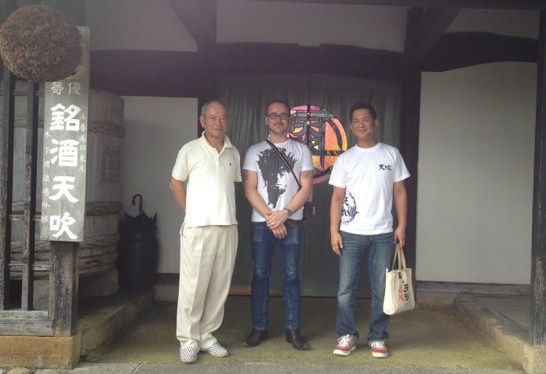The Amabuki Brewery

I’m tired, it’s 7:45am, and any self-respecting bartender is propping up a bar this early in the day. Or in bed. Or on his way to bed. Yesterday evening I arrived back from an intense sake course in Chicago. Being a self-respecting bartender I didn’t make it to my hotel until 4, so I’m a little disoriented and the effects of jetlag are hitting me pretty hard. One of the breweries that was showcased in Chicago was the Amabuki brewery, from Saga Prefecture in Kyushu, and it is towards this destination that I’m currently hurtling through the centre of Tokyo at yay-many hundred k’s an hour.
It sounds more dangerous than it actually is, as I’m on a Shinkansen, a bullet train, and I can say that Australia definitely needs one of these. I’m not particularly interested in hearing about the economic pros and cons of a high-speed rail linking Melbourne to Sydney – it’s a done deal as far as I’m concerned, so long as the trains look this cool…
Anyway, I digress. Amabuki is one of my favourite breweries, and I’ve been hoping to visit them for quite sometime. One of the many interesting about them is the yeasts they use. Amabuki is one of only a handful of breweries in the country that obtain yeast from flowers. I can’t wait to hear all about it from Mr Kinoshita, who is going to meet me at a distant station, somewhere on the other side of Japan.
More about that later. Time to get some sleep. It’s morning after all, and I am a self-respecting bartender…

Wayne in the middle
It’s a beautiful country, Japan. Even blurred at yay-many hundred k’s an hour. Some blurs and micro-sleeps later and I’m met by a smiling Mr Kinoshita. On the drive he gives me some history: Amabuki is in its 10th generation, he’ll be the 11th President, and it was founded 324 years ago.
We arrive at the brewery and enter a beautiful little room to chat over some coffee. Mr Kinoshita explains the story behind the yeasts they use, and the long process of elimination they went through to find them.
We are joined by the President of the brewery, Mr Kinoshita Sr, who goes into greater depth on the importance of the yeasts that they have selected. He uses the beautiful analogy that the relationship between Koji (the ingredient in sake that provides the enzymes that break down the rice into fermentable sugars) and yeast is like the relationship between a script and an actress. Without a decent script for the actress to work with, the end result will be uninspiring. You need a great actress to make a masterpiece, just as you need a great script to allow the actress to shine.
Mr Kinoshita explains that he wants customers to enjoy their sake fresh and young, to appreciate the drink, as Amabuki wants them to experience it. Both gentlemen nod sadly when they think of customers doing shots, thereby not giving themselves time to appreciate the unique qualities of the sake and the passion that has gone into its creation. Getting people drunk is not the reason they are in the business, but they accept that sometimes they have to give the market what it demands.
Next we do a quick tour of the brewery, and then it’s time for tasting. Yeast plays a large part in giving sake its aroma, and with Amabuki’s product this is very evident. They are probably the most aromatic of any sake that I’m yet to taste, and it’s easy to see why Mr Kinoshita wants you to drink them young – though time will help to soften the product, it will also inevitably steal away the zesty freshness of the bouquet.

Tokubetsu Junmai Chokarakuchi Nama
The Omachi Daiginjo is smooth and light, with the unmistakeable smell of berries, while the Aiyama Daiginjo is more full bodied, and all about fresh banana, muscatels and raisins. Though both are spectacular examples of Daiginjo, the showstopper for me is the Yamadanishiki Nama Tokubetsu Junmai. I usually find unpasteurised sake a little sweet for my palette, however, this one is amazing, with a long and moreish finish. A high level of astringency balances the sweetness, and the end result is nothing should of delicious. Unfortunately none of these sakes are currently available in Australia, but you can rest assured that I’ll try to remedy this situation the moment I get back!
Even though the brewery is venerable, Amabuki doesn’t allow tradition to get in the way of innovation. They want to move with the times, continuously refining their practices to create amazing sakes that retain their relevance in the modern world. After this (too brief) visit, I think that it is working for them, and look forward to try the next round of Amabuki sake when it comes.
Kampai!
T.S.A.
………………………………………………………………………………………………………………………………………………………………………
 |
Wayne Shennen According to Wayne Shennen, good bartending is all about balancing flavours. “The subtlety of each ingredient should shine through,” explains the passionate New Zealander, a trained sake sommelier and one of Sydney’s most respected bartenders at award-winning Saké Restaurant & Bar. “If you can taste what you’re drinking, you tend to treat alcohol with more respect.”a |
Saké Restaurant & Bar
12 Argyle Street
The Rocks, Sydney
t. 02 9259 5656
The Sake Alchemist #2
The Sake Alchemist #1
Tasting Business at Saké Restaurant & Bar




